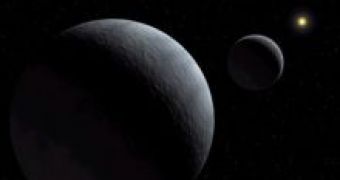Being in the right place at the right time: Astronomers from the Massachusetts Institute of Technology (MIT) in Cambridge and Williams College in Williamstown observed the light from a star as it disappeared behind Charon, Pluto's largest moon, and reappeared on the other side - an event known as a stellar occultation. Occultations provide important information about the size of remote bodies, as well as the makeup of their atmospheres (if they have them). Although the star disappeared behind Charon for less than a minute, data from the observations provided considerable information about this tiny moon. In a paper released in the January 5, 2006, edition of Nature, the MIT-Williams collaboration determined Charon's radius to be 606 ? 8 km. The size was combined with mass measurements from Hubble Space Telescope data to establish a density for Charon of 1.72 g/cm3. This density, roughly 1/3 that of the Earth, reflects Charon's rocky-icy composition. What makes this achievement so remarkable is that the observation could only be made from a narrow, 650-mile wide region in South America. The MIT-Williams observers were located at four telescopes in Chile and one telescope in Brazil for the event. Observations were successful at all stations excluding Brazil, which was clouded out.
Observations taken at a high rate, 10 frames per second, from the 6.5-meter Clay telescope in Chile (which was built by a collaboration of institutions including MIT) detected a certain optical effect, called diffraction, caused when the starlight passed the edge of Charon's disk. Diffraction is caused by the wave nature of light: this is why the shadow of a small object is not compact, it has certain "diffraction fringes". The diffraction fringes appear because a crest of the light wave can overlap on a trough or on another crest. Thus, there is a succession of light and dark areas. By analyzing the distance between these fringes one can draw certain conclusions about the object e.g. can deduce its sharpness. By analyzing the diffraction fringes the MIT-Williams team concluded that any atmosphere on Charon is less than one millionth the density of Earth's atmosphere. Their analysis provided very strict limits on the amounts of various gases that could be present. Three years earlier, the team previously used the technique of stellar occultation to study Pluto's thin atmosphere, showing that it was subject to slight global warming. The results of the observations argue against the theory that Pluto and Charon were formed by the cooling and condensing of the gas and dust known as the solar nebula. Instead, astronomers think that Charon was formed in a collision between two objects early in the formation of the solar system. "Our observations show that there is no substantial atmosphere on Charon, which is consistent with an impact formation scenario," said Nature lead author Amanda Gulbis. "We also find that Charon contains roughly 10% less rock by mass than Pluto. This difference suggests that either, or both, objects involved in a Charon-forming collision had concentrations of heavier materials in their cores." A collisional formation like this has a parallel in theories for the formation of the Earth-Moon system.
Pluto has recently received considerable attention, with NASA's New Horizons mission to be launched in January 2006, the discovery of two new moons, and the discovery of several Kuiper belt objects that are Pluto-sized (or even larger). The success of the MIT-Williams team in observing the Charon occultation bodes well for their ability to observe occultations of different stars by these newly discovered objects.
The so-called "10th planet" (2003 UB313), recently discovered by scientists from Caltech, is a prime candidate for stellar occultation observations. Although this object is approximately twice as far away from the Earth as Charon, it is thought to be twice as large. 2003 UB313 thus covers the same angular extent in the sky as Charon, just as the Moon and the Sun appear to be the same size although the Sun is physically larger.
"We are eager to use the occultation technique to probe for atmospheres around large Kuiper belt objects," remarked Jim Elliot, who has been observing stellar occultations by bodies in the solar system for more than three decades.
Photo Credit: Pluto-Charon system (artist's impression) (Credit: ESO)

 14 DAY TRIAL //
14 DAY TRIAL // 
